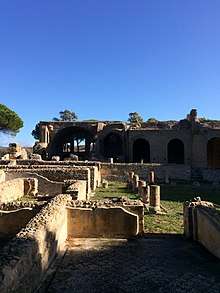Terme Taurine
Terme Taurine, also known as the Taurine Baths, is a former Roman bathhouse complex located outside of the Italian city of Civitavecchia.[1][2] The site contains ruins dating to both Republican and Imperial era Rome, with the oldest structures at Terme Taurine having been built in the first century BC.[3] In modern era, the baths are considered an archaeological park.[2]
 | |
| Location | Civitavecchia, Italy |
|---|---|
| Type | Bathhouse |
| Site notes | |
| Public access | Open |
History
Terme Taurine was first established on a hill overlooking Civitavecchia during the Roman Republican era in the 86 B.C. The bathhouse was known as the Taurine Baths in reference to the nearby village of Aquae Tauri, which is no longer in existence.[3] Local legend holds that the hot spring that the baths were fed by was created when a bull stamped his hoof on ground, causing hot water to spring forth.[3] The republic era ruins at Terme Taurine featured beauty parlors, changing rooms, and hot and cold pools. Several of these pools and the mosaics adorning them can still be visited. The republic era baths also once held a shrine to water nymphs, who were believed by the Romans to be the guardian spirits of underground springs.[2]
The complex at Terme Taurine was greatly expanded by Roman emperor Hadrian (117 - 138 AD) from 123 to 136 AD.[4] The Imperial era baths at Terme Taurine were open to all social classes, with some people being granted free admission. In addition to baths, the Imperial section of Terme Taurine also contained a library and housing for vendors.[3] During the imperial era, the baths became a popular stop-over site for visitors to the nearby port.[5][2]
The baths at Terme remained in use until the mid 6th century, when a war between the Goths and Byzantine Empire resulted in them being looted. Much of the marble walling of the baths was stripped off, and the baths fell into disuse. In 1770 the Papal States began to excavate parts of the site and built an Italian-style garden nearby, which can still be seen.[2]
Notable visitors
During the reign of the Emperor Commodus, Aelius Lampridius recorded that the emperor—upon finding his bathwater lukewarm—had an attendant thrown into an oven while visiting Terme Taurine.[5][6] Roman Poet Rutilius Claudius Namatianus visited the baths in the 5th century and described them in his travelogue.[3]
References
- "MUSEI, MONUMENTI E AREE ARCHEOLOGICHE STATALI" (PDF). Beniculturali.it. Retrieved 9 September 2018.
- Informational panel located at the Terme Taurine cite, produced by the Universa De Roma Departmento De Biologia and the Commune of Civitavechia.
- "Taurine Baths of Civitavecchia". Port Mobility Civitavecchia (in Italian). 2015-03-11. Retrieved 2018-01-07.
- aministra. "Terme Taurine a Civitavecchia". www.museionline.info (in Italian). Retrieved 2019-04-09.
- Heinz, W. (1986). Die ''Terme Taurine'' von Civitavecchia – ein römisches Heilbad. Antike Welt, 17(4), 22-43.
- Historia Augusta. C 1, 9. - Historia Augusta Bd. 1, eingeleitet und übersetzt von E. Hohl, bearbeitet und übersetzt von E. Merten (1976) 138. - E. Mer-ten, Bäder und Badegepflogenheiten in der Darstel-lung der Historia Augusta (Antiquitas. Reihe 4, Bd. 16. 1983) 123.